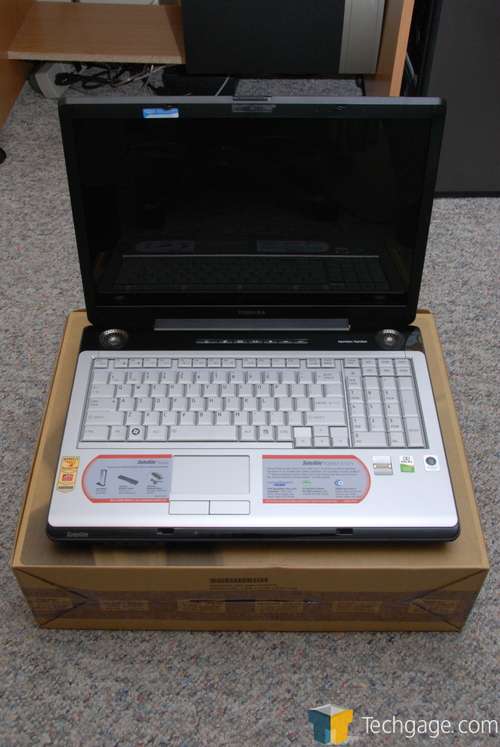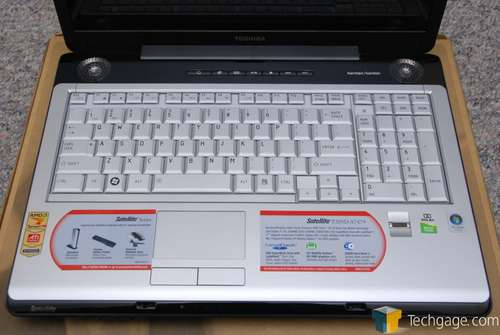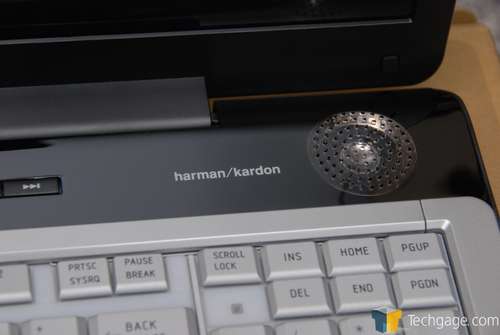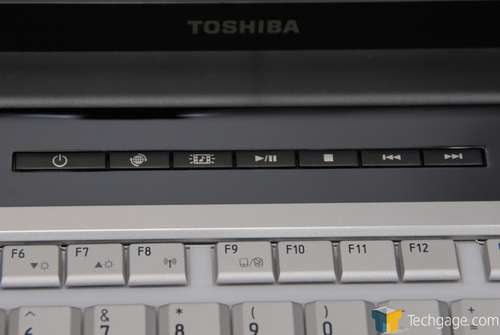- Qualcomm Launches Snapdragon 4 Gen 2 Mobile Platform
- AMD Launches Ryzen PRO 7000 Series Mobile & Desktop Platform
- Intel Launches Sleek Single-Slot Arc Pro A60 Workstation Graphics Card
- NVIDIA Announces Latest Ada Lovelace Additions: GeForce RTX 4060 Ti & RTX 4060
- Maxon Redshift With AMD Radeon GPU Rendering Support Now Available
Toshiba Satellite P205D-S7479
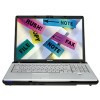
Toshiba’s latest AMD notebook offering proves that even those on a relative budget deserve a feature-packed model. Besides its 17-inch display, the P205D-S7479 offers nice harman/kardon speakers, a thumbprint reader, a large 250GB hard-drive, an ATI HD 2600 – all for a light price.
Page 1 – Introduction
|
|
While AMD may not be dominating the desktop market at this point in time, their notebook processors are doing rather well. Numerous notebook-builders are bundling Turion Dual-Core offerings into their product line-ups, which is great for any consumer who is looking for a low-priced notebook with a solid feature-set.
Case in point: Toshiba’s P205D-S7479. This is the first Toshiba notebook that I’ve had to use over the course of a few weeks, although I’ve been meaning to get one in for quite a while. At CES this past January, their notebooks’ feature-sets impressed me, as did their design. The models I looked at then were high-end however, while the P205D is designed to be affordable for anyone. As we will see though, that doesn’t mean that you will end up with a lackluster machine. Far from it.
Included in the $1,299 price tag is a lot of functionality and nice specs including a large 17″ display, 2.2GHz AMD processor and an ATI HD 2600 mid-range graphics card. The P205D is touted as being a media notebook, so it should prove perfect for all video-viewing along with regular computer usage as well.
Given its specs, the P205D-S7479 is not going to be the perfect gaming notebook – although it will suffice if you don’t mind lowering the graphic detail. The mid-range video card, along with other specs, will not be ideal for any of todays latest releases. At this price-range though, it’s difficult to fault the notebook for its lack of high-end gaming capability.
It will also not appeal to the businessman, thanks in part to its lackluster battery-life (as we will see) and also its heavier weight, at 7.2lbs. Luckily, Toshiba and others have a large variety of notebooks to better “suit” that lifestyle.
Closer Look
The P205D is packed well in a compact box. I appreciate this, because a few ASUS notebooks I’ve reviewed recently have included enough cardboard to build an outdoor shelter. The actual product box is slightly larger than a good briefcase – perfect for storing in a closet or the attic.
The entire cover is glossy black, with a slight shimmer if you look close enough. Where the word “glossy” pops up, so does “fingerprints”, and that’s no exception here. If you are looking to keep the notebook looking as clean as possible at all times, prepare to wipe it off with a soft cloth every few days. The Toshiba logo is silver metallic and perfectly blends with the rest of the cover.
All important information can be found underneath, including the model, serial code, Windows product key, MAC address for the WiFI and various other information. Towards the bottom left-hand and right-hand corners are system fans, while the other opening at the top (relative to your right-hand area during normal use) is an audio subwoofer.
Sure doesn’t look like a $1,300 notebook, does it? Personally, when comparing this model to a similar Dell, I find no comparison. Toshiba has a great design here. It’s feature-packed, yet retains a clean look. The stickers are gaudy, but I believe that consumer models come clean, minus the standard brand-badges, such as Microsoft Windows and Dolby.
The notebook design is common through Toshiba’s notebook line-up, but it works and works well. As mentioned, this looks like a notebook that has a much higher SRP, especially thanks to its harman/kardon speakers. The keyset looks clean and the fact that a full-fledged keypad was included impressed me.
Taking a look around, our first stop is the fingerprint reader. At first, this struck me as odd, because in the past I only recall seeing this functionality on higher-speced notebooks. It’s good to see that it’s becoming more common. These are useful because they allow you to have a very difficult password to crack (and one that’s complicated to type in), while still allowing you to access the OS with a simple swipe of a finger.
The touchpad is a simple affair, but I found it to be fairly accurate. There were a few times when I felt it didn’t respond to my command as it should have, but it was a rarity. The location of the left/right buttons made for comfortable usage in short doses. I am not a fan of touchpads, but was able to get by with this one when I didn’t have a mouse handy. That said, I still prefer a mouse any day over a touchpad.
The included harman/kardon 2.1 speakers are a nice touch and the sound quality is excellent for a notebook of any price-range. Thanks to the subwoofer, there is a fair amount of bass and the sound is quite defined considering the speakers are slammed into a small notebook frame. Headphones will almost always be a better choice for movie-viewing/gaming to have a more robust sound, but if you happen to be without, these speakers will not rub you the wrong way.
The top media keys don’t need much of an explanation, so I won’t delve into it. They are located right above the keyboard as you can see, and are very convenient.
There is no real shortage of connectivity options here, with WiFi, LAN and Modem connections available from the get go. On the left side of the notebook is the LAN port, VGA, 2x USB and an S-Video Out. The right side is where the DVD-RW drive is situated, beside four more USB ports, modem and a Kensington security port.
The front contains audio ports, WiFi enable/disable, card reader and a volume roller. Run your finger left and right on this wheel in order to increase and decrease the volume. I would have preferred an actual volume button on the notebook, but this solution worked fine when I needed it.
The WiFi enable/disable button is one useful feature I found myself using often. Click to turn the wireless off, and no connection will be possible. It beats the need of going into the network manager in Windows Vista to disable the driver manually. This method is far less painful.
I am pleased overall with the layout and functionality of the P205D and don’t have any serious issues to bring up. I personally did not find the keyboard to be to my liking, but I can’t exactly put my finger on why, either. After using it for a half-hour, I found myself becoming more comfortable with it, so it could have been “keyboard-shock” – moving from one notebook to another. Like most notebooks, a slight learning curve might be needed.
On the next page, we will cover the full specs of the P205D-S7479 and also tackle software.
|
|
Support our efforts! With ad revenue at an all-time low for written websites, we're relying more than ever on reader support to help us continue putting so much effort into this type of content. You can support us by becoming a Patron, or by using our Amazon shopping affiliate links listed through our articles. Thanks for your support!






